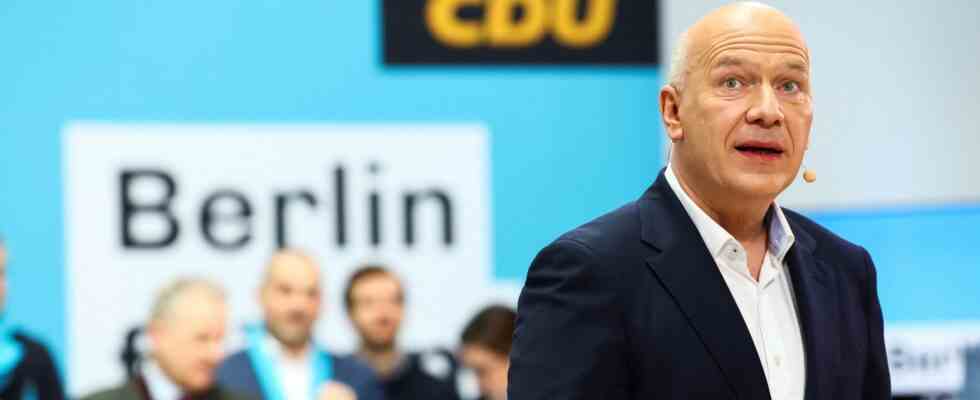Status: 02/12/2023 6:00 p.m
The CDU is far ahead in the repeat election in Berlin. The previously ruling SPD loses and wrestles with the Greens for second place. The Left Party remains in double digits, the AfD increases slightly. The FDP wobbles.
For the first time in more than 20 years, the CDU has replaced the SPD as the strongest political force in Berlin. In the repeat election to the House of Representatives, the party of top candidate Kai Wegner comes according to the forecast Infratest dimap to 27.5 percent. Compared to the 2021 breakdown election, the CDU has gained significantly – at that time it came in third place with 18.0 percent behind the Greens.
Wegner ran with the declared election goal of achieving political change in the capital. As a top candidate, his appeal was comparatively low, but his CDU was apparently able to benefit from the widespread dissatisfaction with the red-green-red Senate and the situation in the city. After the New Year’s Eve riots, she successfully focused on the issues of security and order. It’s been a long time since the CDU was the strongest force in Berlin: in 1999 it won with Eberhard Diepgen. Since 2001, the SPD has governed with changing coalitions.
Giffey without a bonus
The SPD is one of the clear losers of the election. The party of the Governing Mayor Franziska Giffey comes loudly ARD prognosis only to 18.5 percent. In doing so, it undercuts its negative record of 21.4 percent from 2021. Fewer and fewer people in Berlin apparently trust the SPD to get the city’s problems under control.
During her short tenure, Giffey was not able to build up any appreciable official bonus; many Berliners believe that many things in the city simply work too badly for that. During the election campaign, she resisted the impression of Berlin as a “city of chaos” and tried to score points as a hands-on doer and caretaker.
Greens with slight losses
The co-governing Greens and the SPD are in a race for second place. They come to 18.5 percent, which is roughly the level of 2021. Bettina Jarasch ran as a mayoral candidate, but was apparently not able to convince much. As the responsible senator, she was blamed for the everyday traffic chaos in the city. With measures against car traffic in the city, she also polarized. The push for green issues and the tailwind from the federal government are apparently not reaching the state Greens.
With 12.5 percent, the Left Party performs somewhat weaker than in 2021, but remains in double digits. It benefits from its popular top candidate, Klaus Lederer, who has made a name for himself as a long-time Senator for Culture. During the election campaign, Die Linke campaigned for the referendum on the expropriation of housing groups to be implemented quickly. She would like to continue the coalition with the SPD and the Greens.
The AfD can increase a little and now comes to 9.0 percent. She started with top candidate Kristin Brinker. During the election campaign, the New Year’s Eve riots, the renewed immigration debate and the fear of price increases and the further consequences of the war gave her a boost.
FDP below the five percent mark
The FDP has to worry about re-entering the House of Representatives. The party sees the forecast at 4.5 percent. She was able to score points with her rhetorically strong top candidate Sebastian Czaja, but the FDP suffered from the substantive competition with the CDU during the election campaign. There was also little tailwind from federal politics, the FDP is struggling in the traffic light government to meet the expectations of its supporters. In state elections, there have recently been defeats in a row.
Who rules Berlin?
Berlin is now facing a difficult government formation. Presumably, it will again result in a three-party coalition. If the FDP stayed below the five percent mark, it could possibly be enough for a two-party alliance. The CDU, as clearly the strongest force and the only party with large gains, is likely to claim the government mandate for itself, but finding a partner could be difficult. Unlike in Schleswig-Holstein or North Rhine-Westphalia, the ditches to the Greens are deep. The SPD would have to fit into the junior role.
Before the election, a so-called Germany coalition made up of the CDU, SPD and FDP was brought into play. The CDU toyed with such an alliance, and it would hardly fail with the FDP either. But the Liberals would have to make it into Parliament for that to happen.
The continuation of the red-green-red alliance is also conceivable, but whether it will be enough will only become clear during the course of the evening. That also depends on the performance of the FDP. In the election campaign, Giffey had not committed to a coalition preference, but she recently indicated that she would want to forge alliances beyond the CDU even in the event of a CDU election victory.
Unique in Germany
A total of around 2.4 million people were called to the Berlin repeat election. It had become necessary because there were serious glitches and electoral errors during the vote on September 26, 2021, and it was then declared invalid. There has never been anything like this in Germany at state level.
The associated frustration with political actors and loss of trust in institutions is expected to have a negative impact on voter turnout. In the 2021 breakdown election, it was 75 percent, but at the same time the federal election and a referendum took place at the same time. This time, participation could be ten percentage points lower.
Whoever governs in Berlin only has a good three and a half years until the next election. Unlike in a new election, the government only takes over the remainder of the legislative period in this repeat election.

